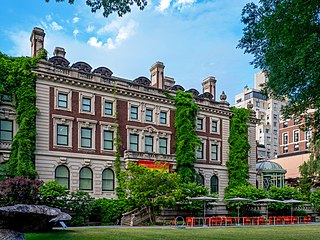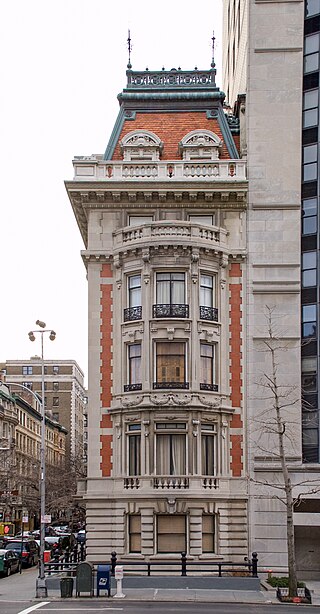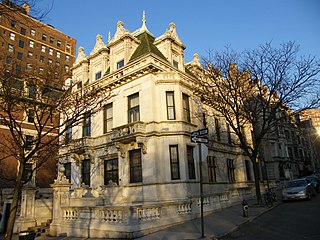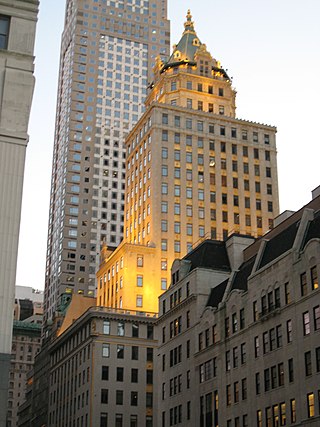
From the late 1870s to the 1920s, the Vanderbilt family employed some of the best Beaux-Arts architects and decorators in the United States to build a notable string of townhouses in New York City and palaces on the East Coast of the United States. Many of the Vanderbilt houses are now National Historic Landmarks. Some photographs of Vanderbilt residences in New York are included in the Photographic series of American Architecture by Albert Levy (1870s).

William Edmond Lescaze, was a Swiss-born American architect, city planner and industrial designer. He is ranked among the pioneers of modernism in American architecture.

The Gertrude Rhinelander Waldo House is a French Renaissance Revival mansion at the southeastern corner of Madison Avenue and 72nd Street on the Upper East Side of Manhattan in New York City, United States. Built between 1894 and 1898, it was designed by Alexander Mackintosh of the architectural firm of Kimball & Thompson. Though the house was constructed for the heiress Gertrude Rhinelander Waldo, she never moved in. The mansion was converted to a commercial building in the 20th century, becoming the New York City flagship store of the Ralph Lauren accessory and clothing company in the 1980s. The mansion is a New York City designated landmark and on the National Register of Historic Places.

York Avenue, Sutton Place, and Sutton Place South are the names of segments of a north–south thoroughfare in the Yorkville, Lenox Hill, and Sutton Place neighborhoods of the East Side of Manhattan, in New York City. York Avenue runs from 59th to 92nd Streets through eastern Lenox Hill and Yorkville on the Upper East Side. Sutton Place and Sutton Place South run through their namesake neighborhood along the East River and south of the Queensboro Bridge. Sutton Place South runs from 57th to 53rd Streets. Unlike most north–south streets in Manhattan, building address numbers along Sutton Place South increase when headed south. Sutton Place runs from 57th to 59th Streets. The streets are considered among the city's most affluent, and both portions are known for upscale apartments, much like the rest of the Upper East Side.

The Andrew Carnegie Mansion is a historic house and a museum building at 2 East 91st Street, along the east side of Fifth Avenue, on the Upper East Side of Manhattan in New York City. The three-and-a-half story, brick and stone mansion was designed by Babb, Cook & Willard in the Georgian Revival style. Completed in 1902 for the industrialist Andrew Carnegie, his wife Louise, and their only child Margaret, it served as the family's residence until 1946. Since 1976, the house has been occupied by the Cooper-Hewitt Museum, part of the Smithsonian Institution. The mansion is internally connected to two townhouses at 9 East 90th Street and 11 East 90th Street, both of which are part of the Cooper-Hewitt.
74th Street is an east–west street carrying pedestrian traffic and eastbound automotive/bicycle traffic in the New York City borough of Manhattan. It runs through the Upper East Side neighborhood, and the Upper West Side neighborhood, on both sides of Central Park.
The Pace Gallery is an American contemporary and modern art gallery with 9 locations worldwide. It was founded in Boston by Arne Glimcher in 1960. His son, Marc Glimcher, is now president and CEO. Pace Gallery operates in New York, London, Hong Kong, Los Angeles, Geneva, Seoul, East Hampton, Tokyo, and Palm Beach.

The Oliver Gould Jennings House is a mansion at 7 East 72nd Street on the Upper East Side of Manhattan in New York City. It is along 72nd Street's northern sidewalk between Fifth Avenue and Madison Avenue. The four-story building was designed by Ernest Flagg and Walter B. Chambers and was built in 1898. The house, along with the neighboring structure at 9 East 72nd Street, has been owned since 2002 by the government of Qatar, which has combined the two buildings into a single residence.

The Henry P. Davison House is a mansion located at 690 Park Avenue and 69th Street on the Upper East Side of Manhattan, New York City.

The Benjamin N. Duke House, also the Duke–Semans Mansion and the Benjamin N. and Sarah Duke House, is a mansion at 1009 Fifth Avenue, at the southeast corner with 82nd Street, on the Upper East Side of Manhattan in New York City. It was built between 1899 and 1901 and was designed by the firm of Welch, Smith & Provot. The house, along with three other mansions on the same block, was built speculatively by developers William W. Hall and Thomas M. Hall. The Benjamin N. Duke House is one of a few remaining private mansions along Fifth Avenue. It is a New York City designated landmark and is listed on the National Register of Historic Places.

The Schinasi House is a 12,000-square-foot (1,100 m2), 35-room marble mansion located at 351 Riverside Drive on the Upper West Side of Manhattan in New York City. It was built in 1907 for Sephardic Jewish tobacco baron Morris Schinasi. Completed in 1909 at the northeast corner of West 107th Street and Riverside Drive, the three-story, 12,000 square foot mansion was designed in neo-French-Renaissance style by William Tuthill.
Mott Brooshovft Schmidt was an American architect best known for his buildings in the American Georgian Classical style.

The Crown Building is a 25-story, 416-foot-tall (127 m) building at 730 Fifth Avenue, on the southwest corner of Fifth Avenue and 57th Street, in the Midtown Manhattan neighborhood of New York City. Constructed between 1920 and 1922 for the philanthropist August Heckscher, the structure was designed by Warren and Wetmore as an office building. The lower levels contain retail space, while the upper levels became the luxury Aman New York hotel and residences in 2022. The structure has been a New York City designated landmark since 2024.
Donald Trump grew up in Jamaica Estates, an affluent neighborhood in Queens, New York City. In 1971, Trump moved into a studio in Manhattan. From 1983 until 2019, Trump's primary residence was the three-level penthouse on the top floors of Trump Tower; in 2019, he declared Mar-a-Lago in Palm Beach, Florida, to be his primary residence. During his presidency from January 20, 2017, until January 20, 2021, Trump resided at the White House in Washington, D.C..

Marc Glimcher is an American art dealer who is the President and CEO of Pace Gallery, a modern and contemporary art gallery founded by his father, Arne Glimcher, in Boston in 1960. He and his father were cited among the top 100 most powerful people in the international art world, according to the annual "Power 100" list published by ArtReview. In 2012, Glimcher sold a Gerhard Richter painting for more than $20 million at Art Basel in Basel, Switzerland.
For people with the surname, see Skarstedt (surname).

10 West 56th Street is a commercial building in the Midtown Manhattan neighborhood of New York City. It is along 56th Street's southern sidewalk between Fifth Avenue and Sixth Avenue. The six-story building was designed by Warren and Wetmore in the French Renaissance Revival style. It was constructed in 1901 as a private residence, one of several on 56th Street's "Bankers' Row".

12 East 53rd Street, also the Fisk–Harkness House, is a building in the Midtown Manhattan neighborhood of New York City, United States. It is along the south side of 53rd Street between Madison Avenue and Fifth Avenue. The six-story building was designed by Griffith Thomas and was constructed in 1871. It was redesigned in the Tudor-inspired Gothic Revival style in 1906 by Raleigh C. Gildersleeve.

647 Fifth Avenue, originally known as the George W. Vanderbilt Residence, is a commercial building in the Midtown Manhattan neighborhood of New York City. It is along the east side of Fifth Avenue between 51st Street and 52nd Street. The building was designed by Hunt & Hunt as one of the "Marble Twins", a pair of houses at 645 and 647 Fifth Avenue. The houses were constructed between 1902 and 1905 as Vanderbilt family residences. Number 645 was occupied by William B. Osgood Field, while number 647 was owned by George W. Vanderbilt and rented to Robert Wilson Goelet; both were part of the Vanderbilt family by marriage.














